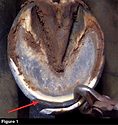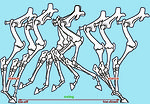Advertise Follow Us
Articles by Stephen O’Grady
Carelessly transitioning a performance horse from shod to barefoot may negatively affect its footcare
Read More
Reprinted with permission from the American Association of Equine Practitioners. Originally printed in the 2019 AAEP Convention Proceedings.
Wooden Shoes Offer a Transitional Solution to a Variety of Hoof Problems
Farriery option stabilizes hoof capsule, promotes hoof wall growth at the coronet and increases sole depth
Read More
How to Identify and Treat Thrush
This article provides an overview of the causes, diagnosis and treatment of thrush
Read More
How to Treat Hoof Abscesses
Farriers and veterinarians often deal with abscesses. Here is some practical advice for understanding and treating these
Read More
An Overview Of Equine Canker
This article provides a summary view of the diagnosis and treatment of this foot disease
Read More
Reprinted with permission from Equine Veterinary Education (EVE). Original published in Equine Veterinary Education Vol 28 June 2016.
Various Aspects Of Barefoot Methodology Relevant To Farriery
This thorough review will help you analyze and plan for transitioning a horse from shod to barefoot
Read More
Sheared Heels and the Correlation to a Quarter Crack
A quarter crack repair will be of little value unless the cause of the defect is not identified and rectified
Read More
Thoughts on Farriery Associated with the Hind Limb of the Horse
Understanding hoof distortions and conformation of the hind limb allows a farrier to apply the appropriate footcare options
Read More
How To Evaluate The Equine Hoof Capsule
Understanding the mechanism of hoof capsule distortion allows the farrier to formulate a treatment plan
Read More












